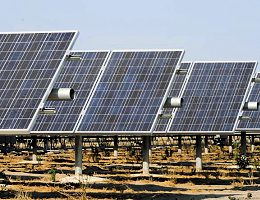 |
|
Fresno Yosemite International Airport |
What began as a small idea to imp rove the rental car facility at Fresno Yosemite International Airport has blossomed into a much larger project that's expected to save the California airport millions of dollars in the coming years.
And it didn't have to invest a nickel.
It all started about this time last year, with a $27-million rental car facility renovation. Shade covers were included to help customers and staff weather Fresno's hot temperatures. To make the most of the new covers, airport officials considered outfitting them with solar panels. But instead of going forward with those solar panels, which would have produced a half-megawatt of power – just a fraction of the airport's needs – the airport found a way to create much more "green power."
Guided by solar-power expert WorldWater & Solar Technologies, the airport turned 9.5 acres of its land that was unsuitable for development into a solar farm able to produce some 4.2 megawatts of power – reportedly enough to satisfy 58% of the airport's need for electricity. Previously, a vineyard occupied the land.
"We'd been looking for a green project to do," says Russ Widmar, Fresno Yosemite's aviation director. "So we put otherwise unusable land to fantastic use."
|
Facts and Figures Project: Solar Farm Location: Fresno (CA) Yosemite International Airport Owner: City of Fresno and Solar Power Partners Consultant/Construction: WorldWater & Solar Technologies Size: 11,700 solar panels on 9.5 acres of land Capacity: 4.2 megawatts Cost: $16 million Construction Time: 9 months Anticipated Savings to Airport: $13 million in first 20 years of operation Panel Manufacturer: Sharp Solar Inverter Manufacturer: Xantrex Of Note: Solar-power investment company paid for construction; land for solar farm was unsuitable for other development Electric Utilities: Pacific Gas & Electric Company |
The farm includes an 11,700-panel solar array with a hydraulic system that moves the structure to track the sun from east to west throughout the day. It runs automatically, providing electricity directly to the airport. If the airport ever needs less power than the farm produces, the excess is sent to the local utility company, which credits the airport against future purchases.
Buying energy at the fixed price agreed to in a long-term contract is significantly less expensive than buying traditional power from Pacific Gas & Electric Company, which generates its power primarily through natural gas. In fact, the airport is expected to save some $13 million over the first 20 years the solar farm is in operation.
It Gets Better
The best part was that it didn't cost Fresno Yosemite anything. Solar Power Partners, a solar power investment company based in California, paid for construction of the $16 million project.
Solar arrays, like the one at Fresno Yosemite, are said to be attractive to investment firms because they offer a modest, but fairly certain, return on investment.
"We did this without any capital investment on our part," Widmar says.
WorldWater & Solar developed, designed and built the facility for Solar Power Partners and has a contract to maintain it.
"Unlike a fossil fuel plant, there's no fuel cost, so the risk for a long-term contract is very low," notes Larry Slominski, vice president of Western region sales for WorldWater.
According to Slominski, that means everyone wins: WorldWater gets paid to build and maintain the facility, investors get a steady return from the solar power produced and the airport gets a large segment of its power at less than market costs.
Not An Easy Connection
Construction of Fresno Yosemite's solar farm included one big challenge: It had to be connected with the Pacific Gas & Electric Company power grid, which was more than 8,000 feet away. In between the two were a four-lane highway, drainage canal, terminal parking, railroad line and an Air Force facility.
 WorldWater & Solar had to bore under all five obstacles to make a successful connection.
WorldWater & Solar had to bore under all five obstacles to make a successful connection.
Fresno's sunny weather, however, was a major plus. In November, Widmar could only remember one rainy day in the previous nine months. And since the airport is nestled in a valley, there is virtually no cloud cover.
While Fresno Yosemite had major advantages in sunny weather and a large expanse of land, neither is a necessity for a productive solar array.
"Obviously, you get more electricity in sunny climates, but there are other financial benefits," Slominski says, noting significant tax breaks and successful farms in decidedly non-sunny locales like Portland and New Jersey.
He predicts the cost of solar production will drop to a point where it will be competitive with traditional fuels, even without tax breaks. That change, he says, could come in the next few years.
There's certainly no shortage of places around airports to add the 3-foot by 5-foot panels. Rental car shades, building facades, roofs, covered parking and windbreaks are just a few of the places Slominski suggests.
Jerry Yago, author of Achieving Energy Independence – One Step at a Time, estimates that it currently takes 100 square feet of panels for each kilowatt of power desired.
 More to Come?
More to Come?
Since its solar farm powered up in July, more than 15 other airports have contacted Fresno Yosemite. "The success of the Fresno Airport project sets a wonderful example for other airports and municipal entities to follow as we all strive to reduce greenhouse gases and manage energy costs," said Alexander Welczeck, CEO of Solar Power Partners at the farm's opening.
While its solar farm has created the likelihood of huge savings and drawn attention from airports as far away as Guam and Puerto Rico, it isn't the only new thing happening in Fresno Yosemite.
Construction of a baggage claim area and renovation of the terminal are currently underway, likely to be completed in summer 2009. The airport has also hired an artist to create replicas of the area's giant sequoia trees for the lobby.


